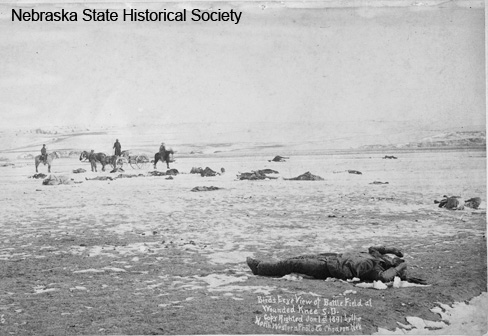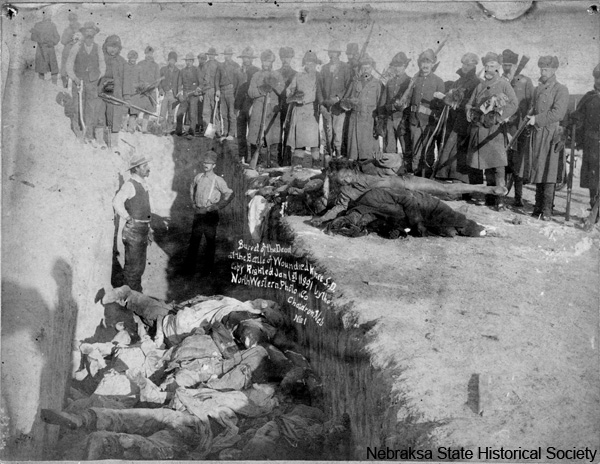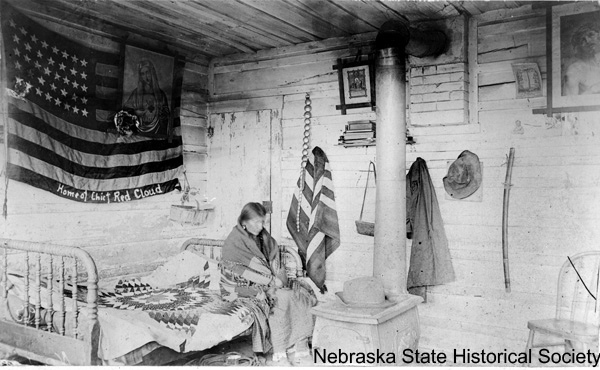 NSHS RG2845-13-6 (at left).
NSHS RG2845-13-6 (at left).
Never before has the story of the Wounded Knee Massacre been so clearly and movingly presented. Three Nebraska State Historical Society staff members (Richard Jensen, Eli Paul, and John Carter) collect the facts and present them honestly. Searching through hundreds of photographs and sources, this team researched exhaustively to discern between lies and truth, rumors and real accounts, integrity and selfish ambition. Eyewitness at Wounded Knee was originally published in 1991, was unavailable for a time, and is now back in print. New technology has allowed for the digital remastering of the scores of photographs, with more than 130 pictures appearing in the book.
In the late 1800s, the world of the Native Americans was disintegrating. By the 1880s, all known groups of Native Americans were on reservations. In 1889, a Paiute shaman named Wovoka claimed to have seen a vision of a Messiah coming to free the Indians, and initiated a religion called the Ghost Dance. It was a mixture of Christianity and Native beliefs. The Ghost Dance taught that if it was followed correctly, the whites would be destroyed, the buffalo and land would be revitalized, and the Native Americans would live freely with their resurrected ancestors.
This message was widely accepted among the Lakota Sioux Indians in South Dakota as salvation, and feared by the U.S. Government as the beginnings of an uprising. Troops were sent to the area, but did not discover the rebellion that the press had led them to expect. Convinced that the arriving troops were going to deport them from America entirely, the Miniconjou Lakotas fled their reservation and headed towards Pine Ridge. On December 29, 1890, the Seventh Cavalry regiment caught up to the escaping tribe with orders to disarm them and return them to the reservation. One Lakota man would not surrender his rifle, and in the scuffle to obtain it, the gun went off. The cavalry then opened fire on the fleeing men, women, and children, resulting in several hours of slaughter. At the end of the ordeal, more than 250 Lakotas were dead, as were 25 soldiers.

One hundred forty-six bodies were interred in a mass grave on the small hill where the Hotchkiss guns had been positioned.
After the massacre, the U.S. Government formed a committee to research and report on the matter. Eyewitness at Wounded Knee uncovers the bias and surface-level nature of this investigation, and then attempts to put aside our own prejudices in order to discover the facts, and decide what really happened at Wounded Knee and who was at fault. Present at Wounded Knee were photographers George Trager and Clarence Grant Moreledge, whose work had never been published before this book. Shortly after the event, a judge named Eli Ricker traveled the area and recorded scores of personal accounts from both sides of the conflict. After his death, his research was donated to the Nebraska Historical Society. His collection is also carefully examined and presented as evidence.
In this book, Jensen, Paul, and Carter wade through a century’s worth of hearsay, false photo captions, and the decay of time to look into the reliability of their sources. Their work is the product of true historians, and provides readers with a clear understanding of the Wounded Knee Massacre that was never before possible. As historian Heather Cox Richardson states in the introduction:
“The authors saw the camera as the ‘eyewitness’ of the title, but by showing what was captured in the camera’s gaze, Eyewitness at Wounded Knee makes the reader an eyewitness to history. We see what the photographer saw. Thanks to the authors’ comprehensive research, we also know the context in which the photographer worked, the people who are in the photographs, and the events that surrounded the still frames.”
We at the Nebraska State Historical Society invite you to witness this moving historical event yourself, in Eyewitness at Wounded Knee. This book is available for $29.95 ($26.95 for NSHS members) from NSHS Landmark Stores.

The home of Lakota leader Red Cloud, who was not present at Wounded Knee but nevertheless was an important political figure of the times. NSHS RG2845-119-05

Here is the same photo (bottom) as it appears in the reprinted version. New technology has allowed for increasing contrast in the photo, making the details more clear.
–Joy Carey, Editorial Assistant, Publications



